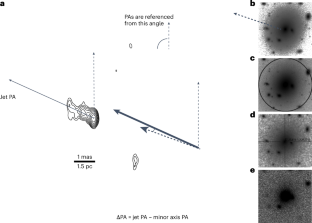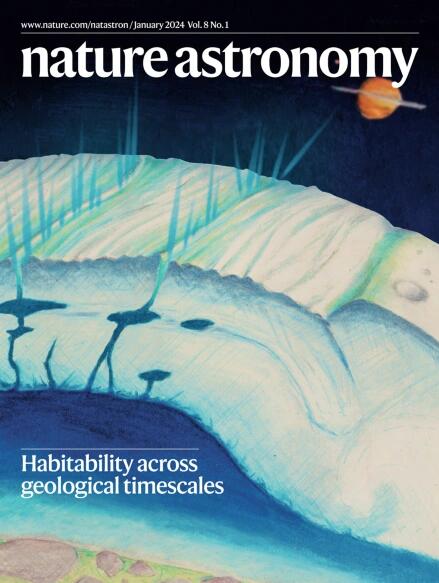Detection of an orthogonal alignment between parsec-scale AGN jets and their host galaxies
IF 12.9
1区 物理与天体物理
Q1 ASTRONOMY & ASTROPHYSICS
引用次数: 0
Abstract
The relationship between galaxies and their supermassive black holes (SMBHs) is an area of active research. One way to investigate this relationship is to compare parsec-scale jets formed by SMBHs to the projected shape of their kiloparsec-scale host galaxies. Here we analyse very-long-baseline interferometry (VLBI) images of active galactic nuclei (AGNs) and optical images of their host galaxies by comparing the inner-jet position angle in VLBI-detected radio sources with the optical shapes of galaxies as measured by several large optical surveys. In total, 6,273 galaxy–AGN pairs were found. We carefully account for the systematics of the cross-matched sources and find that Dark Energy Spectroscopic Instrument Legacy Imaging Surveys (DESI LS) data are significantly less affected by them. Using DESI LS data, with which 5,853 galaxy–AGN pairs were cross-matched, we find a weak but significant alignment signal (with P ≲ 0.01) between the parsec-scale AGN jet and the kiloparsec-scale projected minor axis of the optical host galaxy in sources with measured spectroscopic redshifts. Our results show that the observed source properties are connected over three orders of magnitude in scale. This finding points towards an intimate connection between a SMBH, its host galaxy and its subsequent evolution. The parsec-scale radio jets that form around supermassive black holes are orthogonal to the (kiloparsec-scale) optical shape of the galaxies they’re hosted in, implying an evolutionary connection.


发现等秒尺度AGN喷流与其宿主星系之间的正交排列
星系与其超大质量黑洞(SMBHs)之间的关系是一个活跃的研究领域。研究这种关系的一种方法是将超大质量黑洞形成的秒间隔尺度的喷流与其千秒间隔尺度的宿主星系的投影形状进行比较。在这里,我们分析了活动星系核(AGN)的甚长基线干涉测量(VLBI)图像和它们的宿主星系的光学图像,比较了 VLBI 检测到的射电源的内喷流位置角和几个大型光学巡天测量到的星系的光学形状。总共发现了 6273 对星系-AGN。我们仔细考虑了交叉匹配源的系统性,发现暗能量光谱仪遗留成像巡天(DESI LS)数据受系统性的影响要小得多。利用DESI LS数据(其中有5853个星系-AGN对进行了交叉匹配),我们发现在测量了光谱红移的源中,视距尺度的AGN喷流和千视距尺度的光学宿主星系投影小轴之间存在微弱但显著的排列信号(P≲ 0.01)。我们的研究结果表明,观测到的源特性在三个数量级的尺度上是相互关联的。这一发现表明,SMBH、其宿主星系及其后续演化之间存在着密切联系。
本文章由计算机程序翻译,如有差异,请以英文原文为准。
求助全文
约1分钟内获得全文
求助全文
来源期刊

Nature Astronomy
Physics and Astronomy-Astronomy and Astrophysics
CiteScore
19.50
自引率
2.80%
发文量
252
期刊介绍:
Nature Astronomy, the oldest science, has played a significant role in the history of Nature. Throughout the years, pioneering discoveries such as the first quasar, exoplanet, and understanding of spiral nebulae have been reported in the journal. With the introduction of Nature Astronomy, the field now receives expanded coverage, welcoming research in astronomy, astrophysics, and planetary science. The primary objective is to encourage closer collaboration among researchers in these related areas.
Similar to other journals under the Nature brand, Nature Astronomy boasts a devoted team of professional editors, ensuring fairness and rigorous peer-review processes. The journal maintains high standards in copy-editing and production, ensuring timely publication and editorial independence.
In addition to original research, Nature Astronomy publishes a wide range of content, including Comments, Reviews, News and Views, Features, and Correspondence. This diverse collection covers various disciplines within astronomy and includes contributions from a diverse range of voices.
 求助内容:
求助内容: 应助结果提醒方式:
应助结果提醒方式:


